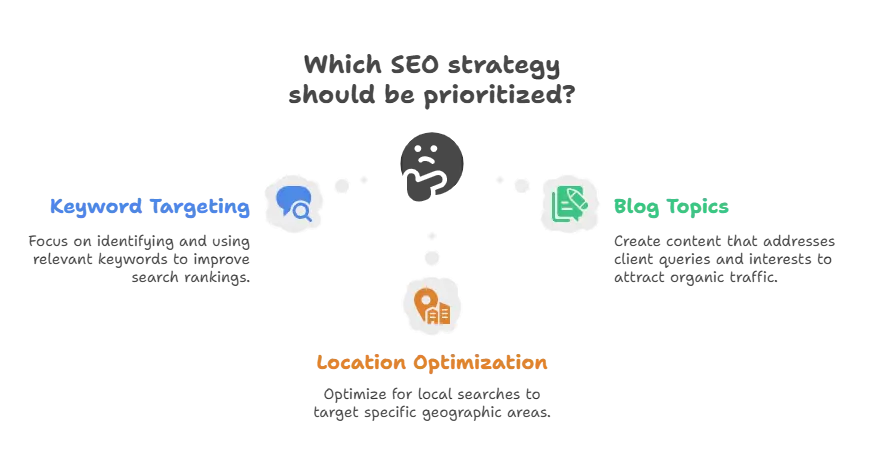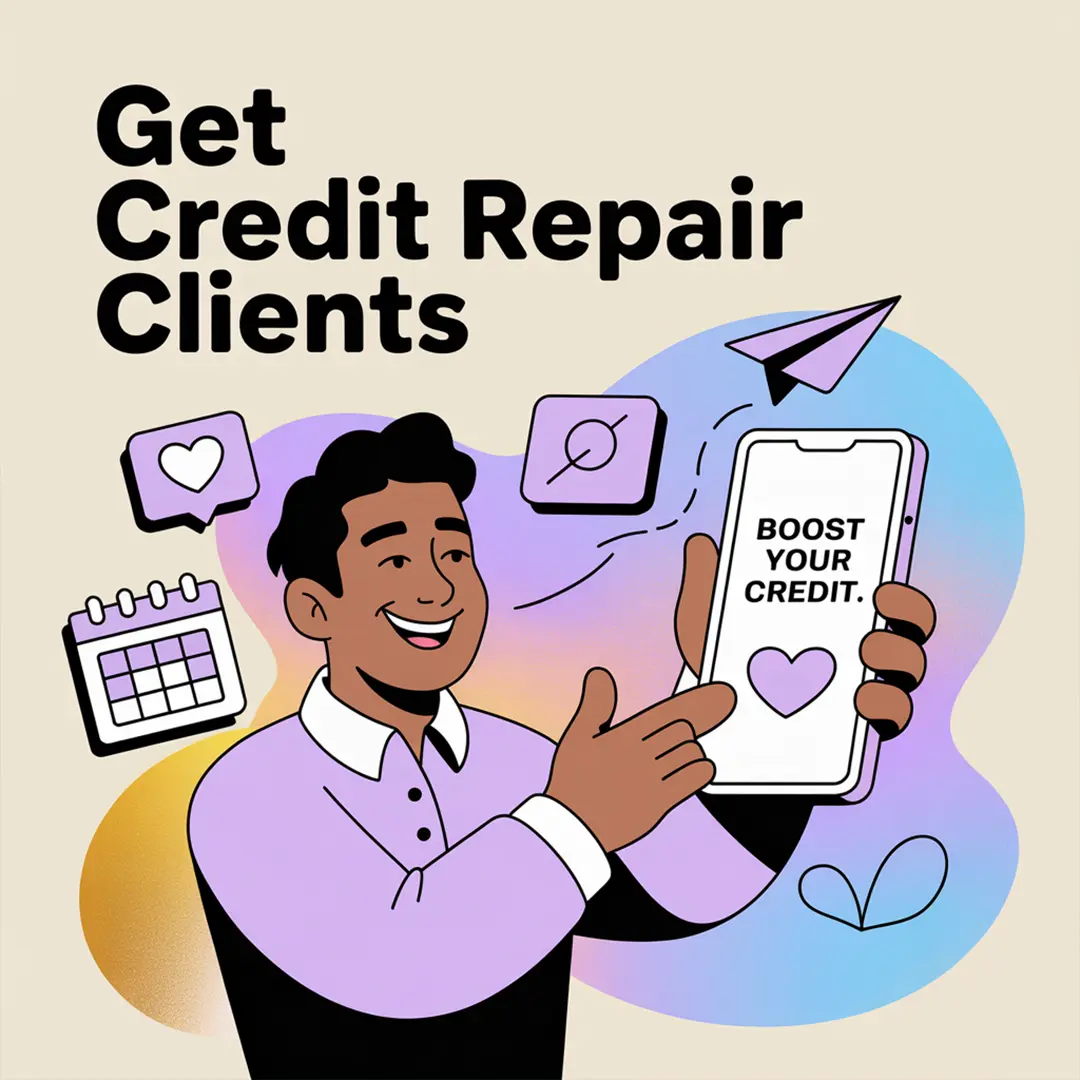Let’s be honest, getting clients for your credit repair business isn’t always easy. You’ve built the foundation, maybe even helped a few people turn their financial lives around, but the leads aren’t coming in like you hoped. You’re not alone. Many credit repair professionals hit the same wall: inconsistent client flow, too much noise in the market, and uncertainty about where to focus their efforts.
But here’s the good news, there are proven strategies that work. From sharpening your brand to building the right partnerships and running smart digital campaigns, you can attract the right clients without burning yourself out chasing cold leads.
This blog unpacks those tactics in detail, with real-world examples, action steps, and trusted sources you can reference or even plug straight into your own marketing. If you’re serious about growing your credit repair business, you’re in the right place. Let’s break it down.
1. Define & Understand Your Target Audience
Importance of Niche Targeting
Trying to market your credit repair services to everyone is a fast way to burn money and time. Niche targeting lets you speak directly to people who actually need your help, whether that’s first-time homebuyers, young professionals with student loan debt, or divorced individuals rebuilding credit. When you define your niche, you make it easier to craft messages that resonate and convert.
Key Demographics to Focus On

Look for individuals who have experienced financial hardship or major life transitions. These include:
- People with sub-600 credit scores
- Individuals recently denied for loans or credit cards
- Renters hoping to qualify for a mortgage
- Millennials and Gen Z entering financial independence
- People with recent bankruptcies or collections
Use tools like Facebook Audience Insights, Google Trends, and Reddit threads to understand their pain points and patterns.
Behavioral Patterns (Where They Hang Out, What They Search For)
Your audience likely spends time in personal finance Facebook groups, follows financial influencers on TikTok or YouTube, and searches Google for terms like “how to fix my credit” or “why did my credit score drop.” Pay attention to:
- Online forums (Reddit’s r/personalfinance, Quora)
- YouTube searches on credit repair
- Facebook or TikTok Lives discussing financial literacy
- Local events like homebuyer seminars or credit clinics
This insight helps you choose the right channels for ads, content, and outreach.
Tailoring Offers and Language
Use plain, empathetic language that reflects their situation. Say things like:
- “Get a free credit review, no judgment, just help”
- “Denied for a car loan? We’ll show you your next step”
- “Let’s rebuild your credit in 90 days, together”
Avoid technical jargon unless you're talking to financially savvy audiences. Lead with outcomes, not services.
2. Build A Strong Brand & Online Presence
Website Essentials: Educational, Trustworthy, Mobile-Friendly
Your website is your digital storefront, and it needs to build trust instantly. At a minimum, make sure it includes:
- Clear explanation of your services
- An about page that shows who you are and why you care
- Easy-to-find contact forms and call-to-action buttons
- Educational content (videos, blogs, FAQs)
- SSL security and mobile responsiveness
Bonus points if you integrate chat support or credit assessment tools.
SEO Strategies: Keyword Targeting, Blog Topics, Location Optimization
Think like your clients: What are they Googling? Use tools like Ubersuggest or AnswerThePublic to identify keywords such as:
- “Fix bad credit fast”
- “How to remove collections from credit report”
- “Credit repair [Your City]”

Write blog posts and service pages around these topics. Don’t forget local SEO, optimize for your city and surrounding areas so you show up in nearby searches.
Social Proof: Reviews, Testimonials, Case Studies
People trust people. Display client testimonials with real names (and photos if allowed).
Create short case studies showing how you helped “John” raise his score from 540 to 690 in four months. Encourage happy clients to leave reviews on:
- Trustpilot
Then feature those reviews prominently on your site and in your content.
Google My Business & Directories
Claim and optimize your Google Business Profile so you appear in local search results. Add:
- Business hours
- Phone number
- Website
- Reviews
- Photos of your office or team
Also, submit your site to local directories (e.g., Yelp, Yellow Pages, BBB) to boost your credibility and improve visibility. Local SEO starts here.
3. Leverage Social Media & Digital Marketing
Running Effective Facebook & Instagram Ads
Social platforms are goldmines for client acquisition, if you use them right. Facebook and Instagram allow you to target users based on credit-related behaviors (like interest in loans, mortgages, or budgeting tools). Run ads with clear hooks and irresistible offers, such as:
- “Get a Free Credit Analysis in 60 Seconds”
- “Denied a Loan? Fix Your Credit Now, Book a Free Call”
Use eye-catching visuals, client testimonials, and short videos. A/B test headlines, calls-to-action, and ad placements. Always send traffic to a high-converting landing page, not a generic homepage.
Creating and Posting Engaging Credit Education Content

Your content should educate and inspire action. Share tips like:
- “3 Credit Mistakes That Hurt Your Score the Most”
- “How to Dispute a Collection Like a Pro”
Use carousels, short videos, infographics, and relatable memes to keep your feed fresh. Highlight real success stories with before/after screenshots (with client permission). Mix education with motivation.
Going Live and Answering Questions
Live sessions on Facebook, Instagram, or TikTok allow you to connect directly with your audience and build real-time trust. Do weekly or biweekly Q&A sessions like:
- “Ask Me Anything About Credit Repair”
- “Credit Score Myths Busted, Live Breakdown”
Answer audience questions, share quick tips, and invite people to book a free consultation afterward.
Establishing Authority in Facebook Groups and Forums
Join relevant groups like first-time homebuyer communities, personal finance groups, or car buyer forums. Don’t just pitch, provide value. Share tips, answer questions, and link to your blog or free resources. Once people see you as a go-to expert, they’ll start reaching out or tagging you for help. It’s slow burn, but it works.
4. Referral Programs & Networking
Creating a Referral System That Motivates Action
Word-of-mouth referrals are powerful, but only if you make it rewarding. Offer clients and partners incentives like:
- $25 gift cards for every successful referral
- 10% off their next billing cycle
- Entry into a monthly giveaway
Keep it simple: provide a referral link or printable card, and automate tracking with basic CRM tools. The easier you make it, the more they’ll share.
Promoting Your Referral Program Across Channels
Don’t just mention your referral program once and forget it. Promote it regularly via:
- Email blasts (“Know someone who needs credit help? Get rewarded.”)
- Website banners and pop-ups
- Social media shoutouts and pinned posts
- Business cards and onboarding documents
Consistency increases visibility, and participation.
Offline Networking: Local Events, Workshops, Professional Circles
Local exposure still matters. Attend or speak at:
- First-time homebuyer seminars
- Local chamber of commerce mixers
- Church or community financial literacy nights
- Industry meetups (real estate, lending, etc.)
Show up with business cards, flyers, and a value-first attitude. The goal: be the local credit repair expert everyone knows and trusts. Relationships built offline can lead to lifelong clients and referrals.
5. Strategic Partnerships
Professions to Partner With: Realtors, Mortgage Brokers, Auto Dealers, etc.
One of the fastest ways to generate quality credit repair leads is by partnering with professionals who already serve clients struggling with credit. Top collaborators include:
- Realtors helping clients qualify for a mortgage
- Mortgage brokers dealing with pre-approvals that fall through
- Auto dealers working with buyers who can’t get financed
- Bankruptcy attorneys, tax professionals, and financial coaches
These professionals want their clients to succeed, and you can help make that happen.
What a Good Partnership Looks Like
An ideal partnership is mutually beneficial, easy to maintain, and built on trust. It might include:
- You offering free credit consultations for their clients
- Co-branded resources (PDFs, checklists, lead magnets)
- A referral fee, commission, or value exchange (they promote you, you promote them)
- Regular check-ins or reporting on referred leads
Make it seamless, no complicated systems or red tape.
How to Pitch Your Services as Mutually Beneficial
When approaching a potential partner, frame it around how it helps their business. For example:
- “I help your buyers qualify faster, so you close more deals.”
- “I’ll handle the credit piece so your clients stay warm, and you don’t lose them to another lender.”
- “Let’s build a trusted referral loop, your clients win, and we both grow.”
Bring a one-page proposal, offer a trial run, and focus on results. This isn’t just collaboration, it’s pipeline building.
6. Host Educational Seminars & Online Courses
Why Financial Literacy Events Attract Leads
People are hungry for credit education, they just don’t want to be sold to. Seminars, workshops, and webinars position you as an expert while offering genuine value. Attendees often fall into your target audience:
- People denied for loans
- Individuals confused by credit reports
- Parents wanting to teach financial habits
And because they trust your knowledge, they’re more likely to become paying clients.
How to Structure a High-Converting Seminar
Keep it simple, engaging, and solution-focused. A sample structure:
- Hook: Share a compelling stat or story (e.g., “1 in 5 credit reports have errors”)
- Education: Break down key topics like “How Scores Are Calculated” or “What Hurts Credit the Most”
- Case Study: Real-life transformation of a client
- Live Q&A: Let people ask questions
- Call to Action: Offer a free consultation or downloadable credit guide
Host in community centers, libraries, churches, or virtually on Zoom.
Turning Online Courses Into Client Funnels
Create low-cost or free courses on platforms like Teachable, Thinkific, or your own site. Topics can include:
- “Credit Repair 101”
- “How to Rebuild Your Score After Bankruptcy”
- “Disputing Collections Like a Pro”
Use the course to build trust, then upsell your done-for-you services for those who want expert help or faster results.
Building an Email List Through Education
Make every registrant or student part of your email ecosystem. Offer free resources (PDFs, templates, checklists) in exchange for their email. Then, nurture with automated emails that:
- Share valuable credit tips
- Tell client success stories
- Promote your services with urgency (“Only 5 spots left for this month’s free consultation”)
Education builds trust, and trust converts.
7. Invest in Targeted Advertising
Google Ads vs. Facebook Ads
Both platforms can work for credit repair, but they serve different purposes.
- Google Ads capture high-intent users, people already searching for solutions like “fix my credit score fast” or “credit repair near me.” It’s pay-per-click, so you only pay when someone clicks.
- Facebook Ads are better for demand generation. You reach people who may not be actively searching but fit your ideal profile (e.g., recently denied a loan, browsing real estate pages, or in debt relief groups).
Use Google Ads for conversion-ready leads and Facebook Ads for awareness and lead nurturing.
Targeting by Behavior and Intent
Get granular. Target your ads by:
- Search keywords like “how to fix credit report errors” or “credit score improvement services”
- Interests and behaviors on Facebook, such as “mortgage lending,” “financial planning,” or “car shopping”
- Life events like recently moved, newly married, or divorced
- Geolocation to attract local clients if your business operates regionally
The better your targeting, the higher your lead quality.
Tracking: Landing Pages, Call Tracking, Pixel Setup
Data is everything. Don’t send ads to your homepage, build dedicated landing pages with clear offers like “Book Your Free Credit Review.” Track performance using:
- Facebook Pixel and Google Ads Conversion Tag
- Call tracking numbers to measure phone inquiries
- CRM or lead capture forms integrated with email or SMS follow-up systems
This lets you see what’s working and double down.
Budgeting and Optimizing for ROI
Start small, $5 to $15/day, and scale what converts.
A/B test your ad creatives, offers, and headlines. Kill underperforming ads quickly and shift budget to winners.
Track Cost Per Lead (CPL) and Cost Per Acquisition (CPA). If it costs you $20 to get a lead but you close 1 in 4, and your average client value is $500+, that’s a great return. Always measure value over volume.
8. Buy Credit Repair Leads (With Caution)
Where to Buy (And Where to Avoid)
Lead marketplaces like Growform, CreditRepairCloud's lead vendors, or LeadRilla are starting points, but not all leads are created equal.
Avoid shady sellers on forums or marketplaces that promise “10,000 leads for $50”, these are often recycled, unqualified, or outright fake.
Stick to verified vendors with refund policies and transparent sourcing methods.
Red Flags When Choosing Lead Providers
Watch for:
- No sample leads or trial period
- Leads that require upfront bulk payment with no performance guarantee
- Poor online reviews or no digital footprint
- Providers who can't explain how the leads are generated
If it feels sketchy, it probably is.
Testing Samples Before Scaling Up
Always buy a small batch first, usually 25–50 leads. Track how many respond, how many are qualified, and how many convert. Set benchmarks before scaling (e.g., “If 1 in 10 leads turns into a call, I’ll buy more”). Also consider running retargeting ads to warm these leads after initial contact.
Building Trust-Based Follow-Up Systems
Most purchased leads won’t convert immediately. Set up automated follow-ups that build trust:
- Email drip sequences with educational content
- SMS reminders and call scripts
- Personalized voicemails or video intros
Lead follow-up should feel helpful, not pushy. The goal is to move cold leads into warm conversations, and from there, into paying clients.
9. Focus on Reputation & Client Experience
Delivering Results with Transparency
Clients don’t just want promises, they want clarity. Be upfront about what credit repair can and can’t do. Explain timelines, legal limitations, and how disputes work. Avoid hype language and focus on realistic, measurable outcomes (e.g., “We aim for a 50–100 point improvement over 90 days, depending on your situation”).
Transparency builds trust, and trust builds referrals.
Gathering and Promoting Reviews
The social proof effect is powerful. Ask happy clients to leave reviews on platforms like:
- Better Business Bureau (BBB)
Make it easy: send a review link with a pre-written template or incentive (e.g., a $10 gift card). Once you’ve got reviews, use them: - Showcase testimonials on your website
- Create social media graphics from 5-star feedback
- Mention positive client results in email campaigns
Managing Expectations and Compliance
Set boundaries early. Explain that credit repair isn’t overnight magic, and avoid making guarantees about score increases.
Stay compliant with federal and state laws, especially the Credit Repair Organizations Act (CROA). Disclose fees, avoid misleading language, and use signed contracts. Not only does this protect you, it also reinforces your professionalism.
Building a Referral-Worthy Client Journey
Think beyond the dispute process. A memorable client experience includes:
- A warm, helpful onboarding process
- Regular progress updates (even when slow)
- Educational tips that empower the client
- A thoughtful thank-you at the end of service
Happy clients talk. Give them a reason to mention you when someone says, “I need help with my credit.”
10. Diversify & Expand Service Offerings
Services That Complement Credit Repair (Debt Coaching, Budgeting, etc.)
Not everyone needs full-service credit repair. Some clients need help with:
- Budgeting and cash flow management
- Debt snowball or avalanche planning
- Student loan advice
- Credit education and monitoring
Offering these services creates multiple entry points for clients at different stages of their financial journey.
Upsell Paths and Client Lifecycle
Think of your clients in stages:
- Credit Crisis (Needs full repair)
- Credit Recovery (Needs monitoring and guidance)
- Credit Growth (Ready for wealth-building)
Your services should match each phase. Examples:
- Start with a $97 credit audit
- Upsell into a $497 repair plan
- Graduate them into monthly credit coaching or a financial wellness subscription
This builds revenue stability and client loyalty.
Becoming a Full-Service Financial Solutions Provider
Position yourself not just as a credit repair specialist, but as a trusted financial guide. Partner with or build in:
- Tax prep services
- Life insurance consultations
- Real estate or mortgage readiness coaching
- Financial literacy courses for families
The more problems you solve, the more value you bring, and the less likely clients are to leave. Expand smartly, and you won’t just fix credit, you’ll build legacies.
Final Thoughts
Growing a credit repair business isn’t just about finding more leads, it’s about building trust, delivering value, and becoming the go-to expert in your niche. The strategies you’ve just read, referrals, partnerships, digital ads, live seminars, and more, aren’t just tactics. They’re long-term plays that compound over time.
Try a few. Test what works for your audience. Refine what doesn’t. The best marketers in the credit space aren’t the loudest, they’re the most consistent and client-focused.
Leave a comment
Your email address will not be published. Required fields are marked *







